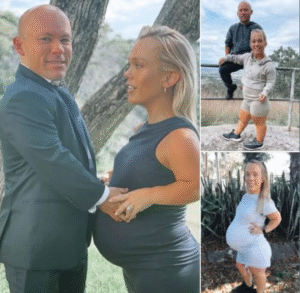Couple with Dwarfism Have Children Against All the Odds
In a world where the odds were stacked against them from the very beginning, a remarkable couple has proven that love, determination, and medical science can defy even the harshest expectations. Their story — one of courage, family, and faith — has touched hearts around the globe and reshaped perceptions about what’s possible for people living with dwarfism.
A Love That Began Beyond Appearances
When Sarah and Michael first met at a conference for people with skeletal dysplasia — a group of conditions that cause dwarfism — neither imagined their lives would soon intertwine so completely. Both stood under four feet tall and had spent much of their lives navigating a world not built for them: door handles too high, cars impossible to drive without modification, and a society that often treated them as curiosities rather than equals.
But amid the shared laughter and conversations about everyday challenges, they found something deeper — understanding.
“From the moment I met him, I didn’t see a man with dwarfism,” Sarah recalls. “I saw someone who made me feel seen for who I really am.”
Within a year, they were married. Their wedding — a joyful, intimate celebration — was a symbol of everything they stood for: resilience, inclusion, and unconditional love.
Facing the Impossible
For most couples, the next chapter — starting a family — would be natural. But for Sarah and Michael, it came with frightening uncertainty. Both have achondroplasia, the most common form of dwarfism. Doctors warned that if both parents carry the gene, there’s a 25% chance their child could inherit two copies, a fatal combination known as double-dominant dwarfism.
The remaining outcomes were:
-
50% chance of a child with dwarfism
-
25% chance of an average-height child
The risk was staggering. Doctors urged them to consider alternatives: adoption, surrogacy, or deciding against biological children altogether.
“I remember leaving the hospital in tears,” Michael said. “It felt like the world was telling us we weren’t meant to be parents.”
But the couple refused to give up. After months of genetic counseling, they learned that new reproductive technologies — including in-vitro fertilization (IVF) with genetic screening — could drastically reduce the risk of fatal outcomes. It would be expensive, stressful, and physically demanding, but it was a chance.
The Journey Through IVF
The process was grueling. Sarah endured weeks of hormone injections, daily blood tests, and sleepless nights filled with anxiety. Out of several embryos, only a handful survived long enough for testing. When results came in, two embryos carried the achondroplasia gene in a non-lethal form — meaning, like their parents, these children would likely have dwarfism but could live full lives.
They chose to move forward. The embryo transfer was a success.
At 32 weeks, Sarah went into premature labor. Complications are common for women with dwarfism due to their smaller pelvic structure, so she delivered via emergency C-section. After hours of tension, baby Lily came into the world — tiny, beautiful, and healthy.
“I just remember hearing her cry,” Sarah said, her eyes welling up. “That sound erased every doubt I ever had.”
A Second Miracle
Three years later, the couple faced the same process again, hoping Lily could have a sibling. This time, the odds seemed even steeper. After two failed embryo transfers, heartbreak, and a miscarriage, they finally received the news they’d prayed for: Sarah was pregnant again.
Their second child, Noah, arrived safely — another small but mighty miracle. Together, the family stood as living proof that limitations exist only where determination ends.
Life as a Family of Four
Today, their home is filled with laughter, noise, and endless adjustments. Every cabinet is lowered, every light switch adapted. Yet what stands out most is the normalcy of their lives — morning routines, messy breakfasts, school drop-offs, bedtime stories.
“Yes, we’re small,” Michael says, grinning, “but our love fills a big house.”
Parenting hasn’t been without challenges. Sarah and Michael face constant stares in public, awkward questions from strangers, and the unrelenting glare of social media whenever their story resurfaces online. But instead of resentment, they’ve turned their visibility into advocacy.
Through public speaking and a YouTube channel, they share their experiences to educate others about disability inclusion, medical discrimination, and the myths around dwarfism.
“We want people to see that we are not defined by our size,” Sarah says. “We’re defined by our choices — and we chose love, hope, and family.”
Breaking Stereotypes
Dwarfism affects roughly 1 in every 25,000 births, and for many, the physical limitations are compounded by social stigma. Hollywood and pop culture have long portrayed people with dwarfism as comic relief or mythical creatures. The couple’s openness challenges that narrative, showing that their lives — their dreams — mirror everyone else’s.
They’ve become advocates for organizations such as Little People of America, working to increase accessibility and dismantle prejudice in workplaces and schools. Their message resonates deeply, especially with other couples facing medical skepticism.
“When people tell us we shouldn’t have had kids, we remind them — every parent takes a risk,” Michael says. “Ours just came with a name.”
A Message to the World
What makes their story so powerful is not just that they had children “against all odds,” but that they redefined what those odds meant. They refused to accept that physical difference equates to limitation. Their journey demonstrates that science and compassion together can create possibilities where none existed before.
Sarah often reflects on how motherhood changed her:
“For so long, I thought the world saw me as small. But when my daughter looks up at me and calls me ‘Mom,’ I feel ten feet tall.”
Looking Ahead
The family now lives in a suburban home modified for accessibility, with low counters, adjustable tables, and step stools that Lily and Noah already treat as climbing playgrounds. Both children inherited achondroplasia, just as doctors predicted. But they’re thriving — running, playing, and growing into confident young individuals.
Every year, on Lily’s birthday, Sarah and Michael revisit the hospital where their journey began. They bring cupcakes to the maternity staff — a small gesture of gratitude for the people who helped them prove the impossible possible.
Conclusion: The Strength of Love
In a world obsessed with perfection, Sarah and Michael’s story is a quiet revolution. It reminds us that love isn’t about statistics or probabilities — it’s about faith, persistence, and an unshakable belief in the future.
They faced doctors who doubted them, strangers who judged them, and risks that terrified them. But through it all, they stood together — a living testament to what it means to fight for your family.
As Sarah often says:
“People think our story is about being small. But really, it’s about how big love can be.”


